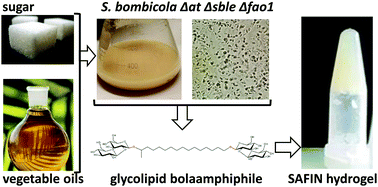Bio-based glyco-bolaamphiphile forms a temperature-responsive hydrogel with tunable elastic properties†
Abstract
A bio-based glycolipid bolaamphiphile (glyco-bolaamphiphile) has recently been produced (Van Renterghem et al., Biotechnol. Bioeng., 2018, 115, 1195–1206) on a gram scale by using the genetically-engineered S. bombicola strain Δat Δsble Δfao1. The glyco-bolaamphiphile bears two symmetrical sophorose headgroups at the extremities of a C16:0 (ω-1 hydroxylated palmitic alcohol) spacer. Its atypical structure has been obtained by redesigning the S. bombicola strain Δat Δsble, producing non-symmetrical glyco-bolaamphiphile, with an additional knock out (Δfao1) and feeding this new strain with fatty alcohols. The molecular structure of the glyco-bolaamphiphile is obtained by feeding the new strain a saturated C16 substrate (palmitic alcohol), which enables the biosynthesis of bolaform glycolipids. In this work, we show that the bio-based glyco-bolaamphiphile readily forms a hydrogel in water at room temperature, and that the hydrogel formation depends on the formation of self-assembled fibers. Above 28 °C, the molecules undergo a gel-to-sol transition, which is due to a fiber-to-micelle phase change. We provide a quantitative description of the Self-Assembled Fibrillar Network (SAFiN) hydrogel formed by the glyco-bolaampiphile. We identify the sol–gel transition temperature, the gelling time, and the minimal gel concentration; additionally, we explore the fibrillation mechanism as a function of time and temperature and determine the activation energy of the micelle-to-fiber phase transition. These parameters allow control of the elastic properties of the glyco-bolaamphiphile hydrogel: at 3 wt% and 25 °C, the elastic modulus G′ is above the kPa range, while at 5 °C, G′ can be tuned between 100 Pa and 20 kPa, by controlling the undercooling protocol.



 Please wait while we load your content...
Please wait while we load your content...
